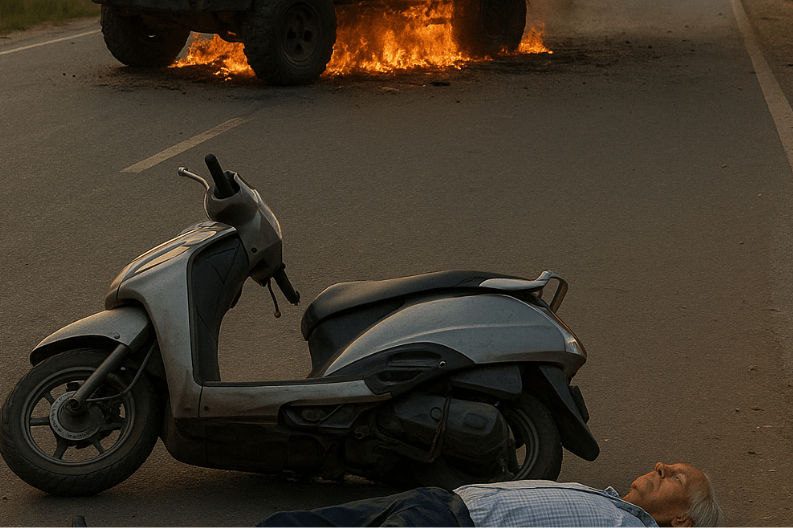Daily News
Tragic Accident on Jalandhar-Hoshiarpur Road Claims Life of 65 Yr
Today, a serious accident occurred on the Jalandhar-Hoshiarpur road, near Nangal Shama link road.

Today, a tragic incident unfolded as accident on Jalandhar-Hoshiarpur road claims life, raising fresh concerns about road safety in Punjab. The accident happened near Nangal Shama link road when a Thar vehicle collided with a scooter. Following the crash, the Thar caught fire, leading to a devastating situation. Sadly, the scooter rider lost his life in the incident.
The crash occurred in the evening when the speeding Thar rammed into an Activa scooter. Witnesses shared that the SUV dragged the scooter for several meters before it exploded in flames. The victim, identified as Hardev Singh, 65, was a respected former Congress sarpanch of Nauli village in Adampur. His sudden death has deeply shocked the community, which remembers him for his decades of service and dedication to public welfare.
After the collision, the Thar driver fled the scene before authorities could arrive. Emergency teams, including fire services and police, reached quickly and controlled the blaze. Investigators have started collecting CCTV footage and eyewitness statements to track down the absconding driver. Police say reckless driving and overspeeding are likely causes of the accident.
This tragedy highlights a growing problem in Punjab. Road safety remains a serious challenge, with around 13 people dying every day in road accidents. According to a 2022 report, Punjab ranks third in India for the highest number of road fatalities. The Jalandhar-Hoshiarpur road, in particular, has a troubling history of accidents due to heavy traffic, poor road conditions, and frequent violations of traffic rules.
Experts believe that several factors contribute to such incidents. Overspeeding, distracted driving, lack of helmets and seat belts, and weak enforcement of traffic laws are major reasons. Additionally, poorly maintained roads and inadequate signage make driving more dangerous. Traffic police have urged drivers to follow rules, reduce speed, and stay alert, especially on high-risk roads like this one.
The government has launched various road safety initiatives, including stricter penalties, better traffic management, and awareness campaigns. Authorities are also planning to install more surveillance cameras, improve road lighting, and fix damaged stretches to prevent future tragedies. However, officials admit that enforcement must become more consistent to make a real difference.
Community involvement is equally important. Local groups and NGOs are organizing awareness drives to educate drivers about safe practices. They encourage wearing helmets, maintaining safe distances, and avoiding drunk driving. Schools and colleges are also including road safety lessons to instill responsible habits in young drivers.
In the wake of Hardev Singh’s death, residents are calling for urgent safety upgrades along the Jalandhar-Hoshiarpur road. Many have demanded speed breakers, more police patrolling, and visible warning signs in accident-prone areas. They believe these steps, along with strict action against reckless drivers, can help save lives.
Ultimately, the heartbreaking loss of a respected leader reminds us that safety on the road is everyone’s responsibility. By following traffic rules, staying aware, and supporting safety efforts, we can reduce accidents and protect lives. The tragedy where accident on Jalandhar-Hoshiarpur road claims life should serve as a wake-up call for all drivers and policymakers to act now before more lives are lost.
Daily News
Jeevika Answer Key 2025 Released: Download PDF and Raise Objections Before December 25

The Bihar Rural Livelihoods Promotion Society (BRLPS) released the provisional Jeevika answer key on December 18, 2025. Candidates who appeared for the Bihar Jeevika recruitment examination can now access their answer keys and response sheets. The exam took place between November 19 and December 15, 2025, covering various positions under the Jeevika programme.
Moreover, BRLPS has opened an objection window for candidates. This allows applicants to challenge answers they believe are incorrect. Subsequently, the society will review all submissions before publishing the final answer key.
Important Timeline
| Event | Date |
|---|---|
| Examination Period | November 19 – December 15, 2025 |
| Answer Key Release | December 18, 2025 |
| Objection Window Opens | December 18, 2025 |
| Objection Deadline | December 25, 2025 |
| Final Results | To be announced |
How to Download the Answer Key?
Candidates must visit the official BRLPS website to access their answer keys. Furthermore, they need their login credentials ready. Here’s the simple process:
Step-by-Step Guide:
- Visit the BRLPS recruitment website at brlps.in
- Enter your application number or login ID and password
- Navigate to the Answer Key/Response Sheet section
- Select your specific post and exam date
- Download the PDF file containing the answer key
Additionally, candidates should download their response sheets. This helps them compare their answers with the official key. Consequently, they can estimate their likely scores before final results arrive.
Raising Objections
The objection process remains straightforward. Candidates who disagree with any answer can challenge it through their personal login. However, they must act quickly as the deadline approaches December 25, 2025.
Objection Submission Process:
- Access the same login portal used for downloading
- Fill out the required objection form
- Pay the applicable fee online for each challenge
- Provide clear justification with supporting evidence
- Submit before the December 25 deadline
It’s important to note that objections apply to specific positions. These include block project manager, livelihood specialist, accountant, office assistant, and block IT executive. However, positions like area coordinator and community coordinator do not have objection provisions.
What Happens Next
After the objection window closes, BRLPS will carefully review all submissions. The review team examines each challenge along with its supporting documentation. Therefore, candidates should provide strong evidence when raising objections.
Following this review, BRLPS will publish the final answer key. This version will reflect any accepted corrections from the objection process. Meanwhile, candidates can expect their scorecards within a few weeks, though officials have not announced the exact result date yet.
The final answer key and results will likely release together or shortly after each other. This allows candidates to understand their performance fully.
Eligible Posts
The recruitment covers multiple important positions:
- Block Project Manager
- Livelihood Specialist
- Accountant (BPIU/DPCU Level)
- Office Assistant (BPIU/DPCU Level)
- Block IT Executive
- Area Coordinator
- Community Coordinator
In conclusion, candidates should download the Jeevika answer key immediately and verify their responses. Those finding discrepancies must submit objections before December 25 to ensure fair evaluation of their performance.
Daily News
John Campbell Returns to RNZ Morning Report: Why the Veteran Journalist Is Trending Today

New Zealand’s veteran broadcaster John Campbell dominated Google Trends on December 19, 2025. The journalist’s name surged in searches after Radio New Zealand announced his exciting return. Campbell will co-host Morning Report alongside Ingrid Hipkiss, marking a significant moment in his broadcasting career.
Furthermore, this announcement comes as part of a broader editorial reshuffle at RNZ. Campbell brings decades of experience and a reputation for championing ordinary people’s issues. His direct interviewing style and clarity make him well-suited for this influential role.
Why This Return Matters?
Morning Report holds deep personal significance for Campbell. In fact, he has listened to the programme since childhood. His parents woke up to it every morning, making those sounds part of his early life.
“My childhood mornings echoed to the sound of it. That makes this programme really special to me. My first understanding of journalism would have been from Morning Report,” Campbell explained. Moreover, he emphasized that the show “gives voice to the less powerful and holds a mirror up to New Zealand life.”
The Broadcasting Shift
| Role | Name | Status |
|---|---|---|
| New Co-Host | John Campbell | Starting 2026 |
| Current Co-Host | Ingrid Hipkiss | Continuing |
| Outgoing Co-Host | Corin Dann | Moving to Business Editor |
| Former Economics Editor | Gyles Beckford | Retiring to part-time |
Campbell will replace Corin Dann, who moves into a new position as RNZ’s Business Editor. Meanwhile, Dann takes over from Gyles Beckford, who enters retirement and transitions to a part-time correspondent role. Therefore, this creates several significant changes across RNZ’s leadership team.
Campbell’s Track Record
RNZ management highlighted Campbell’s impressive achievements. Previously, he hosted Checkpoint and successfully grew audiences during that time. Additionally, his consumer-focused stories consistently resonated with listeners. Consequently, these qualities align perfectly with Morning Report’s format and mission.
The programme remains one of New Zealand’s most trusted news sources. Each weekday morning, it shapes public conversation through in-depth interviews and live coverage. Thus, the co-host position carries considerable influence over how New Zealanders receive and discuss daily news.
What Makes Morning Report Special?
The programme serves several crucial functions:
Key Features:
- Delivers essential daily information and analysis
- Provides voice to less powerful communities
- Holds leaders accountable without bias
- Shapes national conversation each morning
- Offers in-depth interviews with key figures
Additionally, Morning Report has maintained its reputation for journalistic integrity. The show operates “with neither fear nor favour,” as Campbell noted. This independence makes it particularly valuable for New Zealand democracy.
Timeline and Next Steps
Although RNZ announced the appointment, officials have not confirmed Campbell’s exact start date. However, the transition forms part of Morning Report’s 2026 programming schedule. Therefore, listeners can expect to hear Campbell’s voice early next year.
The announcement sparked widespread interest both nationally and internationally. New Zealanders especially showed excitement about Campbell’s return to this iconic programme. In conclusion, John Campbell’s appointment represents a homecoming for the broadcaster and promises fresh energy for Morning Report as it continues serving audiences across New Zealand.
Daily News
Google Pixel Update: Emergency December Fix Targets Battery and Touch Issues
Google has released an unexpected second Google Pixel update this December. This surprise patch comes just two weeks after the company issued its first December security update. The new update addresses several critical issues affecting Pixel 8, 9, and 10 series phones.
Initially spotted on Reddit, users began reporting a small download appearing on their devices. The update file measures approximately 25 MB, suggesting a focused hot fix rather than a major release. Subsequently, Google confirmed the rollout, though the company has not yet posted official factory images.
Key Issues Fixed
The update tackles three main problems:
| Problem | Impact | Affected Devices |
|---|---|---|
| Battery drain | Faster than normal power depletion | Pixel 8, 9, 10 series |
| Touch unresponsive | Intermittent touch failures | Specifically Pixel 10 |
| Cached content | Cannot access offline media/maps | Users upgrading from Android 14 |
Moreover, Verizon has published detailed release notes confirming these fixes. The battery drain issue caused phones to lose power much faster than usual. Meanwhile, Pixel 10 users experienced frustrating touchscreen problems where taps sometimes failed to register.
Limited Rollout
However, this update is not yet widely available. As of Wednesday afternoon Pacific Time, only some users have received it. Verizon customers appear to be getting it first, though reports also come from the UK. Therefore, other carriers may receive the patch later.
This marks Google’s second emergency response this month. Earlier in December, the company rushed out updates after confirming new spyware attacks. Apple similarly acted quickly to protect iPhone users. Now Google demonstrates continued vigilance with this follow-up patch.
Battery Saving Tips
While waiting for the update, users can optimize their battery life through simple settings:
Display Management
- Enable Adaptive Battery under Settings
- Switch to adaptive refresh rates instead of constant 120Hz
- Reduce screen timeout to 30 seconds
- Lower brightness or use adaptive brightness
Background Activity
- Review Battery Usage to find power-hungry apps
- Set non-essential apps to “Restricted” mode
- Limit Always-On Display usage
- Disable apps from waking the lock screen
Location and Connectivity
- Change location access to “Only while using.”
- Turn off precise GPS data for weather apps
- Disable Wi-Fi and Bluetooth scanning when not needed
Furthermore, experts recommend checking which apps run constantly in the background. Android’s built-in Adaptive Battery learns your usage patterns and limits unnecessary activity. Additionally, reviewing app permissions helps prevent excessive power consumption.
Security Implications
The rapid deployment shows Google’s commitment to user security. Cyber security agencies now recommend weekly phone reboots as an additional safety measure. Moreover, users should install updates immediately when available, especially given ongoing attack campaigns.
Although Samsung and other Android manufacturers have not yet deployed this specific patch, they likely will soon if the fixes address system-wide vulnerabilities. In conclusion, Pixel users should check for this crucial Google Pixel update today and install it promptly to resolve battery and touchscreen issues.
-

 City Guide3 years ago
City Guide3 years ago3B2 Mohali Market Shops: Discover 44 Hidden Gems
-

 Entertainment2 years ago
Entertainment2 years agoTop 15 Punjabi Models – Male and Female List
-

 Entertainment3 years ago
Entertainment3 years agoTop 11 Punjabi Comedians of All Time
-

 Jobs4 years ago
Jobs4 years agoTop 20 IT Companies in Mohali
-

 Food4 years ago
Food4 years ago11 Best Restaurants in Mohali You Must Visit
-

 Property2 years ago
Property2 years agoWho Lives In Homeland Mohali: Punjabi Celebrities, Business People…
-

 Food3 years ago
Food3 years agoTop 15 Cafes in Mohali you must visit
-

 Education2 years ago
Education2 years ago10 Famous Punjabi Writers With A Great Impact On The Literary World
